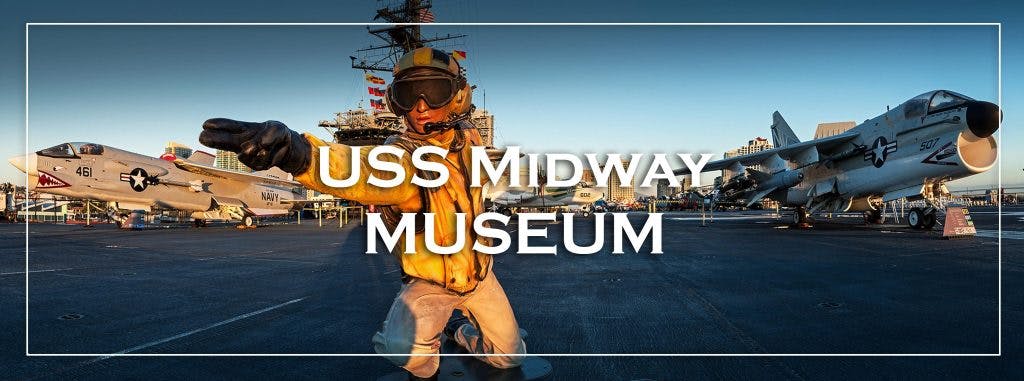 December 05, 2017 | Announcements, Karl’s Korner
December 05, 2017 | Announcements, Karl’s KornerMidway’s New Jet is FURY-ous
Hello Midway Friends! Welcome back to “Karl’s Korner”, a historical segment written by myself, Karl Zingheim - Ship Historian of the USS Midway Museum! As we get ready to head in to a new year, we are making some changes onboard to make the guest experience even better! After years of restoration, we are very proud to introduce you to our newest aircraft...
FJ-3 Fury
Help us “welcome aboard” our newest aircraft to join the Midway’s air wing - the North American FJ-3 Fury! Craned aboard Midway last week, it is an important addition to the Museum’s collection of naval jets from between the Korean and Vietnam War eras. While this vintage warbird was one of the first swept wing aircraft to fly from carriers, it is also part of a complex lineage of aircraft comprising the Fury family that helped define the early jet age in carrier aviation.
Jet-powered aircraft made a dramatic entry in the final months of World War II, and the Navy was determined not to fall behind in this critical aviation development. Three prototype designs were accepted in 1945 from veteran aircraft producer Chance Vought, as well as from newer companies McDonnell Aircraft and North American Aviation. North American was a novice to naval aviation, but it was already a notable producer of combat aircraft for the Army such as the B-25 Mitchell bomber and P-51 Mustang fighter. The North American entry was designated the XFJ-1 Fury, and featured a tubby fuselage with a nose intake and straight, plank-like wings for the low speed stability needed to land on a flight deck. Because the thin wing incorporated deployable speed brakes, there was no room for a wing fold mechanism, so North American’s designers employed a novel kneeling nose castor that could set the parked aircraft in a significant nose-down attitude to permit closer packing of Furies in the limited space of a carrier deck. Though the production FJ-1, introduced in 1948, clearly outperformed propeller fighters of the day, its limited range and short engine life made deploying the Fury problematic. Eventually, McDonnell’s Banshee and Grumman’s Panther jet designs equipped the Navy’s jet squadrons. Combat over Korea in the early 1950s, where the swept-wing Russian MiG-15 was encountered, underscored the need for a naval fighter with higher performance than the straight-wing designs in the naval inventory. Therefore, the Navy looked with interest at North American’s offer of producing a naval version of its highly successful swept wing F-86 Sabre, which was then battling the MiG-15 over Korea. Since Congress was unwilling to fund entirely new designs, but would sustain an improvement of an existing type, the Navy carried the Fury name over to the new offering from North American, and adjusted its designation to XFJ-2 instead of a more appropriate XF2J. Essentially an F-86E with a tailhook, a lengthened nose strut for catapult takeoffs, wing folding mechanisms, and 20mm cannon armament, the FJ-2 displayed landing problems on flight decks, so this version was sent to the Marines to fly from land bases, much like earlier F4U Corsairs in World War II. Another problem was the added weight, some 1,000 pounds, that the naval modifications produced when compared to the Air Force F-86, which impaired overall performance. Because of the Fury’s persistent nose gear problems, the Navy relied on Grumman’s swept wing update to its Panther, known as the Cougar, to equip carrier squadrons. A more powerful engine overcame the Fury’s weight issues, and greatly improved overall performance. By 1955, Navy squadrons were taking delivery of the FJ-3 just as new developments like the optical landing system, and air-to-air missiles arrived. However, even more capable fighters, such as Vought’s supersonic F8U Crusader and McDonnell’s F3H Demon, were going into production not long after the FJ-3 arrived in the Fleet. Meanwhile, North American designed a new naval jet with a deeper fuselage and much larger wing around the original Fury pattern. Though really an all-new aircraft, the same Congressional funding restrictions caused this new aircraft to be designated the FJ-4 Fury. The improvements over the FJ-3 included a much greater range, and an ability to carry a substantial bomb and air-to-ground missile payload. These Furies formed the basis for jet attack squadrons, and from 1956, the FJ-4 fulfilled this role until superseded by the purpose-built Douglas A-4 Skyhawk by the end of the 1950s. As the new decade dawned, supersonic flight was the norm for fighters, and improved attack jets were taking shape. Furies of all types faded from the inventory, being relegated to reserve squadrons or to boneyards. Yet, no other tactical carrier design could boast of such a variegated lineage: from straight wing to swept, and then to a greatly enlarged airframe performing a different mission. The FJ Fury is indeed a welcome addition to the Midway airwing! Do you love the Fury as much as we do, leave us a comment below! Thank you for reading, liking, sharing & commenting.
Launch em’... until next time,
Karl
Your Adventure Starts Now
Your email is the key to information that will open up all your possibilities for exploring the mighty Midway!

